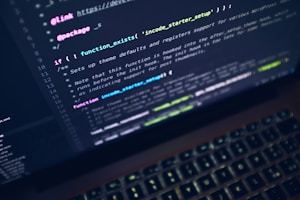introduzione
Windows 10 è uno dei sistemi operativi più popolari di Microsoft, ma a volte può soffrire di problemi di prestazioni. Questa guida ti fornirà alcuni suggerimenti e trucchi per ottimizzare il tuo sistema Windows 10 e aumentarne le prestazioni e l'efficienza.
1. Pulisci il tuo sistema
Nel corso del tempo, il tuo sistema può diventare ingombro di file non necessari, che possono rallentare le prestazioni del tuo computer. Utilizza lo strumento di pulizia del disco integrato per ripulire file temporanei, file di sistema e altri file non necessari.
1. Press Win + S to open the Search menu.
2. Type "Disk Cleanup" and click on the corresponding result.
3. Select the drive you want to clean up (usually the C: drive) and click OK.
4. Check the boxes for the types of files you want to delete (eg temporary files, system files).
5. Click OK and then click Delete Files to confirm.2. Disabilitare i programmi di avvio non necessari
I programmi di avvio sono applicazioni che si avviano automaticamente all'avvio del computer. Avere troppi programmi di avvio può rallentare il tempo di avvio del sistema. Per disabilitare i programmi di avvio non necessari:
1. Press Ctrl + Shift + Esc to open the Task Manager.
2. Click on the "Startup" tab.
3. Identify the programs you don't need to start automatically and right-click on them.
4. Choose "Disable" from the context menu.3. Ottimizza le impostazioni di alimentazione
Windows 10 ha diverse modalità di alimentazione per bilanciare prestazioni ed efficienza energetica. Per ottimizzare le impostazioni di alimentazione:
1. Press Win + X and click on "Power Options."
2. Select the power plan that best suits your needs. "Balanced" is usually a good choice.
3. Click on "Change plan settings" for the selected power plan.
4. Adjust the settings for "Turn off the display" and "Put the computer to sleep" according to your preferences.
5. Click on "Change advanced power settings" to access more advanced options.
6. Adjust the individual power settings to optimize performance and energy efficiency.4. Aggiorna i driver
Driver obsoleti o incompatibili possono influire negativamente sulle prestazioni del sistema. Per aggiornare i driver:
1. Press Win + X and click on "Device Manager."
2. Expand the categories and locate the device you want to update.
3. Right-click on the device and choose "Update driver."
4. Select "Search automatically for updated driver software" and let Windows search for the latest driver.
5. Follow the on-screen instructions to complete the driver update.5. Disabilita gli effetti visivi non necessari
Mentre gli effetti visivi possono rendere Windows 10 più attraente, possono anche consumare risorse di sistema. Per disabilitare gli effetti visivi non necessari:
1. Open File Explorer and right-click on "This PC" (or "My Computer") and select "Properties."
2. Click on "Advanced system settings" in the left sidebar.
3. In the "Performance" section, click on "Settings."
4. In the "Visual Effects" tab, select "Adjust for best performance" or manually choose the effects you want to disable.
5. Click OK to save the changes.6. Disabilita i servizi non necessari
Windows 10 viene fornito con molti servizi che vengono eseguiti in background, consumando risorse di sistema. La disabilitazione dei servizi non necessari può contribuire a migliorare le prestazioni. Tuttavia, è importante essere cauti quando si disabilitano i servizi, poiché alcuni potrebbero essere essenziali per il proprio sistema.
1. Press Win + R to open the Run dialog box.
2. Type "services.msc" and press Enter to open the Services window.
3. Locate the service you want to disable, right-click on it, and select "Properties."
4. In the "Startup type" dropdown menu, select "Disabled" to prevent the service from starting automatically.
5. Click OK to save the changes.7. Usa un antivirus
Il malware può rallentare notevolmente il sistema e comprometterne la sicurezza. Installa un software antivirus affidabile ed esegui scansioni regolari per mantenere pulito il tuo sistema.
8. Aggiorna Windows
Microsoft rilascia regolarmente aggiornamenti per Windows 10 per correggere bug, migliorare le prestazioni e potenziare la sicurezza. Assicurati che il tuo sistema sia aggiornato installando gli ultimi aggiornamenti di Windows.
1. Press Win + I to open the Settings app.
2. Click on "Update & Security."
3. Click on "Check for updates."
4. If updates are available, click on "Download and install" to install them.
5. Restart your computer if prompted.Conclusione
Seguendo questi suggerimenti e trucchi, puoi ottimizzare il tuo sistema Windows 10 e migliorarne le prestazioni e l'efficienza. L'esecuzione regolare di attività di manutenzione e l'aggiornamento del sistema contribuiranno a garantire un'esperienza di elaborazione fluida ed efficiente.

